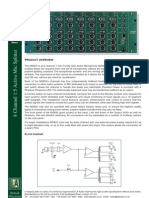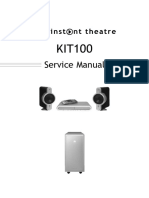Aussie Android Roms: Technical Stuff
Uploaded by
Tunas AndirantoAussie Android Roms: Technical Stuff
Uploaded by
Tunas AndirantoPlease Donate just $1
C hoose your ROM
Installation Tutorials
Howtos
Downloads & Add-ons
FAQ
Subscribe
AusseA
i ndrodiROMS
Repository of Android ROMS modded by Aussie's
Technical stuff
Terms Used in Kernel Builds
What is the difference Between HAVS and SVS?
HAVS changes the voltages used for each frequency, SVS has fixed voltages. HAVS should give
better battery life, SVS should be more stable. Using lower voltages or higher frequencies can make
your phone unstable.
What is the difference between CFS and BFS?
You could write a thesis on this, in fact this is pretty close to a thesis. For those that just want a
little knowledge, both are CPU schedulers, that attempt to schedule multiple processes so they get
an appropriate slice of the CPU resources. CFS outperforms BFS in minimizing process turnaround
time but BFS outperforms CFS for minimizing latency. This indicates that BFS is better for interactive
tasks that block on I/O or user input (like your phone) and CFS is better for batch processing that is
CPU bound. CFS generally seems more stable in . At least one user has found that BFS makes video
playback with Rockplayer (and probably other Video players) jumpy. BFS may also cause occasional
jumps in audio playback.
What is AXI and NOAXI?
The memory throughput is directly proportional to the AXI (internal bus) frequency. For AXI builds,
the AXI freq is coupled with the CPU freq to prevent the memory from being the bottleneck when the
CPU is running at one of its higher frequencies. This will cause an increase in power consumption
when the CPU is running at higher frequencies, but will give a better performance/power ratio
[hugonz]. AXI should further reduce the battery usage when the screen is on. However, 128Mhz IS
INCOMPATIBLE WITH THIS!!!. So if you want to use the AXI patch, use SetCPU and define a
profile that sets the minimum speed to 256Mhz when the screen is on, and sets it back to 128Mhz
when the screen is off. This is NOT necessary with the ManU kernels as it is done automatically by
the kernel. [EViollet]
What is the difference between BFQ, VR, SIO, NOOP and Deadline?
These are I/O schedulers. VR is supposed to be the best for Android see this
What is the difference between SLUB, SLAB, SLOB and SLQB?
These are slab allocators. The slab allocator has been at the core of unix kernels memory
management for many years. This allocator (sitting on top of the low-level page allocator) manages
caches of objects of a specific size, allowing for fast and space-efficient allocations. Kernel hackers
tend not to wander into the slab code because its complex and because, for the most part, it works
quite well. SLQB seems to be favoured by most AOSP kernels. Detailed article here
What are DATA2EXT (D2E) and DATA2WHATEVER (D2W)?
(Thanks to Dani for this)
Moving the whole /data system partition onto the SD card was the original concept
by darkstrumn named data2sd. The first developer (ownhere) who wrote a stable script that moved
/data to the SD card called it data2ext (now dont get confused, there are other versions, but this one
moves it to sd ext partition not the sdcard FAT32 partition). All implementations requires a primary
FAT32, then a primary EXT (and that depends on their script, plus many other factors). But basically
what they want is to move /data into the EXT partition of your card so people will have HUGE Internal
phone memory whatever they choose. Though there are limitations, particularly dont partition EXT more
than 2GB.
Another developer (melethron) decided to make it more flexible in moving the /data structure and
called it DATA2WHATEVER!!! The main difference is that the partition can be EXT2, EXT3, EXT4, BTRFS,
Reiserfs, and it is still evolving right now i dont know where it will end.
The name only implies it can work with any partition, but there are still issues about sdcard speed and
type, and more.
For most of us, We use EXT3 as partition. I tried ext2, ext4, reiserfs, btrfs, and my sdcard is not liking
it. So i stick with EXT3. Its up to you what to use though.
Conclusion: DATA2SD and DATA2EXT are the same thing, and require an EXT3 partition.
DATA2WHATEVER can supposedly use many differents formats for the partition.
Some advice if you are trying the Data2Anywhere experimental version.
Melethron has suggested here to avoid using reboot.
DONT use the reboot of snqs powermenu (or any other reboot app)
DONT use anything in the ROM Manager that makes it reboot.
DONT do adb reboot / abd reboot recovery / adb reboot bootloader
DONT pull the battery while the phone is on (this should be obvious)
DONT remove the sync mount options for the Quadrant boost (this is a fake boost anywa
All of the above are like a powerloss for the sd-card and have a high change of data
corruption
From my test with this I give you an estimate what can happen if a powerloss occurs or any of the 5
Search ROMS-Au (Type word, hit enter)
Please Support Team-Au !
Comment
Category Archive
faxeel: did u see
www.htcdev.com. there
is bootloader service
provided by HTC....
dobaczenko: Quit the
terminal Emulator, stop it
(Menu>settings>applications&...
Baqir: hello: There is
something problem in live
streaming channels on
Villa...
Jezames: let me first say
guys awesome work on
this ROM, ive got S-OFF
CM7 HBOO...
ozjubb: Have a look here:
http://www.romsau.com/installation/extras/alpharev/...
Nicholas: I probably
sounf like a complete
noob. But whats S-OFF
and how do I pu...
Most Popular Topics
Choose your ROM
Desire - InsertCoin_Oz - Ozjubb
Desire - Villain_Au - Talbess
Updating ClockWorkMod &
4EXTRecovery
Desire - T-Mod Express MrInsane
Installation Tutorials
HTC Sensation Rooting with
revolutionary.io
Radios, Radios, Radios
Updating ROM's and Radios
Desire - RCMix_Oz_- Ozjubb
THANKS!! for your Donations
StevenV $80!!, NatB $50, BruceC
$50, VeiC $30, BrendonB $25, BrettI
$25, NathanD $20, ShaunC $15,
KarelynV $10, MarkM $10, PatrickL
$10, LawrenceS $10, TimN $10
May: TrevorM, AdityaP, JeremyA,
HiteshK
June: TinaL, DavidO, MatthewR
August: Myk
Sept: MichaelS, CraigN, DayneF
Select Language
converted by Web2PDFConvert.com
Everything about ROMS
points above happen:
50% general chance of corruption that will be autofixed on boot (not a problem)
Please Donate just $1
Choose your ROM
10% chance of forcecloses after reboot of some apps (this can be fixed by deleting the app data or
Desire MIUI_Au Fllash
restoring it with titanium (or other) backup)
Desire Villain_Au Talbess
REALLY tiny chance (didnt happen for me in over 40 simulated powerlosses) that partition gets
Desire InsertCoin_Oz
Ozjubb
corrupted (needs complete repartitioning of the microSD so all data on it will be gone then)
Desire T-Mod Express
As long as you watch the 5 points above and as long as you dont drop the phone and the battery
MrInsane
Desire RCMix_Oz_- Ozjubb
jumps out this will be safe
Desire T-Mod
What is Busybox?
Muskie/Ozjubb
An application providing a standard set of unix tools. The default toolbox provided by android is limited,
Desire S Proxuser v0.9
Talbess
so this is required to allow rooted roms/apps to use more advanced unix features. Busybox is included in
Nexus S infin1ty Jonathon
most custom ROMs including -Au.
Nexus S Carbon Jonathon
Installation Tutorials
What is the Dalvik-cache?
Motorola Atrix Rooting
When your phone starts up, the Dalvik Virtual Machine looks at all your apps and frameworks, and
Full Video Tutorial Desire
creates a tree of dependencies which is stored in the dalvik-cache. This allows applications to run in an
HTC Sensation Rooting with
revolutionary.io
optimised state (and explains why your phone takes longer to boot up after applying a new rom, its
HTC Desire S Rooting with
rebuilding the cache.) Dalvik cache is typically 40+Mb and you can read more on the Dalvik VM
revolutionary.io
here and here. BTW apparently the author has ancestors from Dalvik, Iceland (or so the story goes).
Required Downloads
Preparation
Zipalign?
Rooting
Zipalign is an archive alignment tool in the Android SDK that provides important optimization to Android
Issues with Unrevoked on
PVT4 Desires
application (.apk) files. The purpose is to ensure that all uncompressed data starts with a particular
ROM Installation
alignment relative to the start of the file. The benefit is a reduction in the amount of RAM consumed
Restore your data
when running the application.
Updating ROMs and Radios
Extras
ODEX DEODEX?
Updating ClockWorkMod &
.DEX files are compiled-code versions of APKs that are created on-the-fly by Android, namely by Dalvik
4EXTRecovery
VM, hence the name: *D*alvik *EX*exutable. ODEX are Optimized DEX files that are created ahead of
AlphaRev for S-Off
Changing Hboot
time for System apps with the DexOpt SDK tool. The benefit is that these apps start up faster because
Unrooting your phone back
of the optimization. The drawback is that the APK thats been ODEXed will not work without the
to stock
Fixing USB Brick
corresponding .odex file present, which almost doubles the size of the app. Deodexing means you
Videos
convert it back to a .dex file and put it back inside the apk. This allows the programmer to easily replace
Common Install Problems
files (not having to worry about odexes), but the main point was to deodex services.jar so that
Howtos
Create SD Card ext3 partition
programmers can change all text to different colors (such as the clock color to white) and to deodex
updating to ext4
services.jar, you need to deodex everything.
Windows tool for acessing
Can I include HTC sense modules in by adding them to the ROM before flashing?
phone
Migrate Data+Apps to new SD
Unfortunately, you cant just grab any of the HTC Sense apps as they usually rely on the Sense
Card
framework to work properly (which is why we cant have HTCs camera app, and HTCs FM radio).
/dev/block/mmcblk0p2 error
Compile a kernel from source
Chrome Operating System Chromebooks are built and optimized for the web. Learn more. google.com/chromebook
Add or Remove built in Apps in
Complete Email Marketing Better Marketing = Better Results. Boost Email ROI Today. Free Guide! www.exacttarget.com/EmailMarketing ROM
Change bootanimation
Automate VMWare Processes Automate VMWare IT Housekeeping. Learn More. Free Whitepaper. UC4.com/Free-Whitepaper
Reset Battery Indicator
Market not Downloading /
Installing
Cant see some preinstalled
No Comments
Apps
Cant update preinstalled Apps
Boost Battery life
Leave a Reply
Get Faster GPS Fix
Best ways to Stuff your SD
Name (required)
Card
Downloads & Add-ons
Howto Translate
Mail (will not be published) (required)
Top 10 Apps
Australian Apps
Website
Use APKTool to Decompile,
Edit, Translate and Recompile
an APK
XJs tools to automate APKTool
FAQ
What is ROMS-Au?
A2SD Explained
Hboot Schemes Explained
Radios, Radios, Radios
kernels, kernels, kernels
Backup and Restore
Glossary
Technical stuff
Common Problems
Submit C omment
Telstra APNs
Links
Android Antivirus App Free Android Antivirus & Security Download it from Android Market! market.android.com/Norton
MainPlan CMMS
Dropbox for Teams Simplify your business life with our new enterprise product www.dropbox.com/business
UOT Kitchen
U.S. Cellular Phone Sale Android 2.2 & Dual Touch Screens. Visit U.S. Cellular to Buy Now! www.uscellular.com/LGGenesis
[XDA] Android Development
forums
[XDA] GingerVillain
[XDA] InsertCoin Nightly
Using Gravatars in the comments - get your own and be recognized!
[XDA] InsertCoin Stable
[XDA] LeeDrOid
XHTML: These are some of the tags you can use: <a href=""> <b> <blockquote> <code> <em> <i>
[XDA] Oxygen
<strike> <strong>
[XDA] Proxuser Desire S
[XDA] RCMix
converted by Web2PDFConvert.com
Aussie Android ROMS is powered by WordPress using theme Renegade II patched by talbess
converted by Web2PDFConvert.com
You might also like
- Android Kali NetHunter Install - Android 15No ratings yetAndroid Kali NetHunter Install - Android 1540 pages
- (GUIDE) Making Dump Files Out of Android Device PartitionsNo ratings yet(GUIDE) Making Dump Files Out of Android Device Partitions11 pages
- SMS of Death: From Analyzing To Attacking Mobile Phones On A Large ScaleNo ratings yetSMS of Death: From Analyzing To Attacking Mobile Phones On A Large Scale17 pages
- User's Manual: FDC 4100 / 7100 / 8100 / 9100 Auto-Tune Fuzzy / PID Process / Temperature ControllerNo ratings yetUser's Manual: FDC 4100 / 7100 / 8100 / 9100 Auto-Tune Fuzzy / PID Process / Temperature Controller60 pages
- Internet of Smart Cards - A Pocket Attacks ScenarioNo ratings yetInternet of Smart Cards - A Pocket Attacks Scenario15 pages
- Control Your Android Phone From Your Computer With Scrcpy - Ghacks Tech NewsNo ratings yetControl Your Android Phone From Your Computer With Scrcpy - Ghacks Tech News15 pages
- Finfisher: Finspy 3.10 User Manual: Finusb Suite SpecificationsNo ratings yetFinfisher: Finspy 3.10 User Manual: Finusb Suite Specifications52 pages
- How To Guide - Samsung A22 5G FRP Reset using SP Flash Tools - Works irrespective of Android versions installed. _ XDA Forums100% (1)How To Guide - Samsung A22 5G FRP Reset using SP Flash Tools - Works irrespective of Android versions installed. _ XDA Forums7 pages
- Computer Security Questions and Answers:: 1:: What Is A Firewall?No ratings yetComputer Security Questions and Answers:: 1:: What Is A Firewall?9 pages
- This Is A Tutorial Meant For Hacking A Website!No ratings yetThis Is A Tutorial Meant For Hacking A Website!3 pages
- Exploiting Smart-Phone USB Connectivity For Fun and Profit: Angelos Stavrou & Zhaohui Wang!100% (1)Exploiting Smart-Phone USB Connectivity For Fun and Profit: Angelos Stavrou & Zhaohui Wang!35 pages
- 23 Android Apps That Every Root User Should Have!No ratings yet23 Android Apps That Every Root User Should Have!15 pages
- Learn Website Hacking / Penetration Testing From ScratchNo ratings yetLearn Website Hacking / Penetration Testing From Scratch15 pages
- Unpairing Apple Watches - Printable VersionNo ratings yetUnpairing Apple Watches - Printable Version11 pages
- VOIP Hacking - What Is VOIP and How To Hack VOIP ServicesNo ratings yetVOIP Hacking - What Is VOIP and How To Hack VOIP Services22 pages
- Confidence A 2018 Practical Guide To Hacking RFID NFC PDF50% (2)Confidence A 2018 Practical Guide To Hacking RFID NFC PDF148 pages
- Doxing: Doxing (From Dox, Abbreviation of Documents)No ratings yetDoxing: Doxing (From Dox, Abbreviation of Documents)8 pages
- Proxy Servers and Anonymizers, Password Cracking - 1606227811100% (1)Proxy Servers and Anonymizers, Password Cracking - 160622781116 pages
- Evil Mass Storage - DriverEntry - Article by Daniel BrooksNo ratings yetEvil Mass Storage - DriverEntry - Article by Daniel Brooks13 pages
- Here's How Easy It Is To Make Your Own IMSI-CatcherNo ratings yetHere's How Easy It Is To Make Your Own IMSI-Catcher3 pages
- Advanced Hacking Techniques:: Implications For A Mobile WorkforceNo ratings yetAdvanced Hacking Techniques:: Implications For A Mobile Workforce10 pages
- (Kernel) Semaphore Ics 0.9.1 (0.9.5B) : ZiogtsNo ratings yet(Kernel) Semaphore Ics 0.9.1 (0.9.5B) : Ziogts5 pages
- (Kernel) Semaphore Ics 0.9.1 (0.9.5B) : ZiogtsNo ratings yet(Kernel) Semaphore Ics 0.9.1 (0.9.5B) : Ziogts5 pages
- 50 Most Frequently Used Linux Commands PDF100% (2)50 Most Frequently Used Linux Commands PDF58 pages
- Rugby MSF Controlled Alarm Clock: GeneralinterestNo ratings yetRugby MSF Controlled Alarm Clock: Generalinterest9 pages
- BIOS Password and Locked Hard Disk RecoveryNo ratings yetBIOS Password and Locked Hard Disk Recovery4 pages
- VESTEL Installationsguide EVC04-AC11SW-T2P ENNo ratings yetVESTEL Installationsguide EVC04-AC11SW-T2P EN47 pages
- Technical Rockwell Automation FactoryTalk HistorianNo ratings yetTechnical Rockwell Automation FactoryTalk Historian6 pages
- Cumulus Linux Quick Reference Guide For NX-OS Users100% (1)Cumulus Linux Quick Reference Guide For NX-OS Users29 pages
- Configuration and Readback of The Spartan-II and Spartan-IIE FPGA FamiliesNo ratings yetConfiguration and Readback of The Spartan-II and Spartan-IIE FPGA Families38 pages
- Bosch MTS 6516 VCI Technical Data BrochureNo ratings yetBosch MTS 6516 VCI Technical Data Brochure2 pages




































































































